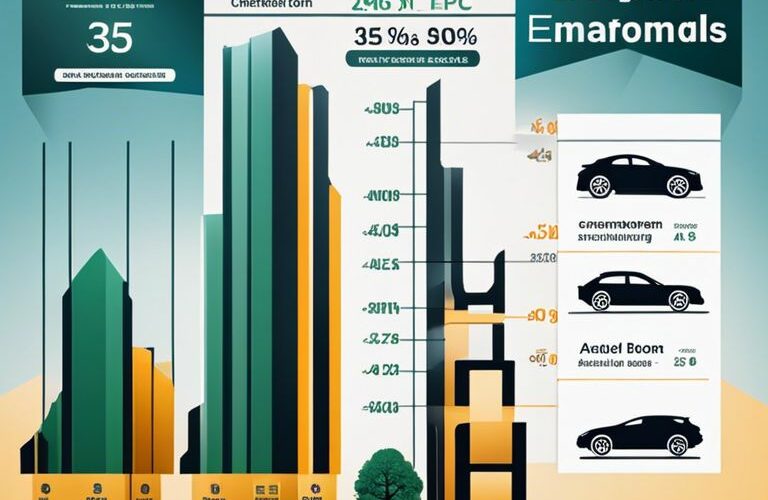Delve into the world of car emission standards with this in-depth guide on Euro Classes. Understanding Euro Class standards is crucial for drivers, as they determine the amount of harmful pollutants vehicles release into the environment. As concerns over air pollution and its impact on global climate change continue to grow, it is essential to be well-informed about the emission regulations that govern vehicles on the road.
Table of Contents
The Evolution of Euro Class Standards
From Euro 1 to Euro 6: The Journey of Improvement
Improvement in car emission standards has been a critical focus over the years, leading to the development of various Euro classes. The journey began with Euro 1 in 1992, which set the first standards for vehicle emissions, focusing primarily on carbon monoxide (CO) and hydrocarbon (HC) emissions. Subsequent Euro classes, from Euro 2 to Euro 6, have introduced stricter limits on emissions of pollutants such as nitrogen oxides (NOx) and particulate matter (PM).
This progression reflects advancements in automotive technology and the increasing awareness of the environmental impact of vehicle emissions. Each new Euro class represents a milestone in the industry’s efforts to reduce harmful pollutants and improve air quality, driving manufacturers to innovate and develop cleaner engine technologies.
Understanding the Timeline and Implementation
An essential aspect of Euro class standards is the timeline for implementation. Each new Euro class sets deadlines for when new vehicles must comply with the updated emissions standards. This phased approach allows manufacturers to adapt their production processes and incorporate new technologies gradually, ensuring a smooth transition to cleaner vehicles for consumers.
Types of Emissions Covered by Euro Standards
While understanding Euro emission standards, it is important to grasp the various types of emissions that these standards aim to regulate. The Euro standards primarily focus on reducing harmful emissions such as carbon monoxide (CO), nitrogen oxides (NOx), particulate matter (PM), and hydrocarbons (HC). By effectively controlling these pollutants, Euro standards contribute to the overall improvement of air quality and public health.
Knowing the specific pollutants targeted by Euro standards helps in comprehending the significance of adhering to these regulations for both manufacturers and vehicle owners. To delve deeper into the subject, let’s explore each type of emission covered by the Euro standards in detail.
| Carbon Monoxide (CO) | Nitrogen Oxides (NOx) |
| Particulate Matter (PM) | Hydrocarbons (HC) |
Carbon Monoxide (CO)
The emission of carbon monoxide (CO) in vehicle exhaust is a result of incomplete combustion of fuel. The presence of carbon monoxide in the air can be harmful as it reduces the blood’s ability to carry oxygen to the body’s tissues. With Euro standards in place, vehicles are mandated to limit the emission of carbon monoxide, thus mitigating the negative impact on both human health and the environment.
The stringent regulations set by Euro standards ensure that vehicles equipped with efficient emissions control systems can effectively reduce the release of carbon monoxide into the atmosphere, promoting cleaner air quality for all.
Nitrogen Oxides (NOx)
On average, nitrogen oxides (NOx) account for a significant portion of harmful emissions produced by vehicles. These compounds are formed during the combustion process at high temperatures. The presence of NOx in the atmosphere contributes to the formation of smog and acid rain, impacting both human health and the environment.
Carbon dioxide, nitrogen oxides, and other pollutants emitted by vehicles are closely monitored under Euro standards to ensure that emission levels are within permissible limits, safeguarding air quality and promoting sustainable practices.
Particulate Matter (PM)
Covered under Euro standards, particulate matter (PM) consists of tiny particles released into the air from vehicle exhaust. These particles can pose a serious threat to respiratory health and overall air quality. By regulating the emission of particulate matter, Euro standards aim to reduce the health risks associated with inhaling these pollutants.
Matter such as soot, dust, and other microscopic particles are controlled through Euro standards to limit their release into the environment, ultimately improving air quality and reducing the negative impact on public health.
Hydrocarbons (HC)
Euro standards also address the emission of hydrocarbons (HC) from vehicle exhaust. These compounds are released during the combustion of fuel and are known to contribute to the formation of ground-level ozone and smog. By regulating the emission of hydrocarbons, Euro standards play a crucial role in reducing air pollution and its detrimental effects on both human health and the environment.
Euro emission standards set specific limits on the release of hydrocarbons from vehicles, encouraging the use of cleaner technologies and fuels to minimize the impact of these pollutants on air quality.
Specific Standards for Diesel and Petrol Engines
Monoxide and nitrogen oxides are particularly concerning emissions in diesel engines, while petrol engines are known for higher hydrocarbon and nitrogen oxide emissions. The Euro standards tailor specific regulations for each engine type to address the unique characteristics of their emissions, ensuring that both types of engines contribute to a cleaner environment.
Emissions from diesel and petrol engines are closely monitored to comply with Euro standards, emphasizing the importance of reducing harmful pollutants to protect public health and the environment. Adhering to these specific standards plays a crucial role in achieving a sustainable future for the automotive industry.
Factors Influencing Emission Levels
Not all vehicles are created equal when it comes to emission levels. Several factors play a crucial role in determining the amount of pollutants released by a car into the atmosphere. Understanding these factors is essential for making informed decisions about vehicle usage and environmental impact.
- Vehicle Type and Engine Size
- Fuel Quality and Type
- Driving Style and Conditions
- Maintenance and Vehicle Age
Vehicle Type and Engine Size
For vehicle emissions, the type of vehicle and its engine size are key factors. Smaller, more fuel-efficient cars tend to produce lower emissions compared to larger vehicles with powerful engines. Generally, diesel engines emit more pollutants than petrol engines due to their combustion process.
Additionally, factors like the age of the vehicle and its overall condition can also impact emission levels. Older vehicles or those with inefficient engines may emit higher levels of pollutants into the environment.
Fuel Quality and Type
Size matters when it comes to fuel quality and type. The quality of fuel used in a vehicle directly affects its emission levels. Low-quality or contaminated fuel can lead to incomplete combustion and higher emissions of harmful pollutants. Additionally, the type of fuel used, such as petrol, diesel, or alternative fuels, can also influence emission levels.
This is particularly important for vehicles equipped with advanced emission control systems, such as catalytic converters, as the wrong type or quality of fuel can damage these components and increase emissions.
Driving Style and Conditions
Type of driving style and conditions can significantly impact emission levels. Aggressive driving, frequent acceleration and braking, and driving at high speeds can all increase emissions from a vehicle. In contrast, smoother driving, consistent speeds, and proper maintenance can help reduce emissions and improve overall efficiency.
With regular maintenance and adherence to proper driving practices, vehicle owners can minimize their environmental impact and ensure their vehicles operate at peak performance levels for a longer period.
Maintenance and Vehicle Age
On average, maintenance and vehicle age are critical factors influencing emission levels. Regular maintenance, including air filter replacements, spark plug changes, and emission system checks, can help ensure that a vehicle operates efficiently and emits lower levels of pollutants. Additionally, newer vehicles equipped with advanced emission control technologies tend to produce fewer emissions compared to older models.
A well-maintained vehicle not only reduces its impact on the environment but also improves fuel efficiency and overall performance. Investing in regular maintenance and timely repairs can help extend the lifespan of a vehicle while keeping emissions in check.
Euro Classes: A Step-by-Step Guide to Compliance
Despite the growing concern over vehicle emissions and their impact on the environment, many drivers are still unclear about what Euro classes are and how they affect their vehicles. Euro classes refer to the emission standards set by the European Union to regulate pollutants emitted by vehicles. These standards are designed to reduce harmful gases and particles that contribute to air pollution and climate change.
| Euro Class | Emission Standards |
| Euro 1 to Euro 4 | Introduced between 1992 and 2005, these standards aimed to reduce emissions of carbon monoxide, hydrocarbons, and nitrogen oxides. |
| Euro 5 and Euro 6 | Implemented from 2009 onwards, these standards focus on reducing particulate matter emissions and further lowering nitrogen oxide levels. |
Identifying Your Vehicle’s Euro Class
To determine your vehicle’s Euro class, you can check the registration or logbook, where the Euro class should be listed. Additionally, you can look up the specific Euro class of your vehicle on the manufacturer’s website or contact the manufacturer directly for more information.
It’s important to note that newer vehicles are likely to have a higher Euro class, indicating that they meet stricter emission standards and are more environmentally friendly.
Tips for Maintaining Low Emission Levels
Your driving habits and maintenance practices can significantly impact your vehicle’s emission levels. To reduce emissions and stay compliant with Euro standards, consider the following tips:
- Regularly service your vehicle to ensure it is running efficiently and cleanly.
- Drive smoothly and avoid harsh acceleration to minimize emissions.
The way you drive and maintain your vehicle plays a crucial role in limiting its environmental impact. The more conscious you are of your emissions, the better for the planet and future generations.
Retrofitting and Upgrades for Older Vehicles
The option of retrofitting or upgrading older vehicles to meet newer Euro standards is available for drivers who want to reduce their emissions. Retrofitting involves adding new emission control technologies to older vehicles, while upgrades may include replacing certain components to improve performance and reduce pollutants.
Euro standards are continually evolving to address growing environmental concerns. While older vehicles may not meet current Euro classes, retrofitting and upgrades can help extend their lifespan and reduce their impact on the environment.
Understanding Testing and Certification Processes
Retrofitting vehicles to comply with Euro standards requires thorough testing and certification to ensure they meet the specified emission limits. Manufacturers or authorized facilities conduct these tests to verify that the retrofitted vehicles meet the required standards before they can be certified for road use.
Emission testing and certification processes are essential to guarantee that vehicles comply with Euro classes and are not emitting harmful pollutants beyond permissible limits. This ensures that vehicles on the road are environmentally responsible and contribute to cleaner air quality.
Pros and Cons of Euro Class Standards
| Pros | Cons |
| Reduction in harmful emissions | Cost implications for manufacturers and consumers |
| Forcing innovation in cleaner vehicle technologies | Potential impact on vehicle performance |
| Improvement in air quality and public health | Challenges and criticisms from industry |
| Harmonization of standards across Europe | Complexity and enforcement of regulations |
| Promotion of sustainable transportation | Resistance from older vehicle owners |
Environmental Benefits
For every new Euro class standard introduced, there is an immediate positive impact on the environment. The reduction in harmful emissions such as nitrogen oxides and particulate matter leads to a significant improvement in air quality and public health. Furthermore, the strict standards encourage automakers to innovate and develop cleaner vehicle technologies, ultimately promoting sustainable transportation.
Impact on Vehicle Performance
Impact on Vehicle Performance
Consistently meeting stricter Euro class standards can potentially impact vehicle performance in terms of fuel efficiency and overall power. Automakers may need to make adjustments to engines and exhaust systems, which could lead to increased costs for manufacturers and potentially higher prices for consumers.
Cons: It is essential to consider the balance between environmental benefits and potential impact on vehicle performance when implementing new Euro class standards. Manufacturers and consumers need to weigh the costs and benefits carefully to ensure a successful transition to cleaner transportation technologies.
Cost Implications for Manufacturers and Consumers
Pros
Vehicle manufacturers investing in research and development to meet Euro class standards may initially face increased production costs. However, in the long run, the innovation and transition to cleaner technologies can lead to cost savings through improved efficiency and reduced maintenance. Consumers may experience higher upfront costs for vehicles complying with stricter standards, but they can benefit from lower fuel consumption and reduced emissions in the long term.
Vehicle manufacturers and consumers alike need to adapt to the cost implications of complying with Euro class standards, balancing the initial investment with long-term benefits for both the environment and the economy.
Challenges and Criticisms
Pros
Any significant regulatory changes, such as the introduction of new Euro class standards, are met with challenges and criticisms from various stakeholders. Industry players may resist the stricter requirements due to potential impacts on production processes and costs. There are also concerns about the complexity and enforcement of regulations across different regions, as well as resistance from owners of older vehicles who may face restrictions or increased fees.
Any resistance and criticisms should be addressed through clear communication, stakeholder engagement, and support measures to ensure a smooth transition to cleaner and more sustainable transportation technologies.
Navigating Euro Class Standards: Practical Tips for Consumers
Keep yourself informed about the latest Euro class standards to make well-informed decisions when purchasing a new or used vehicle. Consider the following tips:
- Check the vehicle’s Euro class rating to understand its emission levels and environmental impact.
- Look for vehicles that meet the latest Euro 6 standards for lower emissions and better air quality.
- Consider opting for hybrid or electric vehicles to reduce your carbon footprint and contribute to a cleaner environment.
This will help you make a conscious choice that aligns with your environmental values and contributes to a greener future for generations to come.
Buying a New or Used Vehicle: What to Look For
For consumers looking to purchase a new or used vehicle, it is essential to consider the Euro class standards of the vehicle. Ensure that the vehicle meets the latest emissions standards to minimize its impact on the environment and public health.
When buying a used vehicle, ask for its emission test records to have a clear understanding of its environmental performance over time. This information will help you make an informed decision that benefits both you and the environment in the long run.
Fuel Efficiency and Emission Reductions: Maximizing Benefits
To maximize the benefits of fuel efficiency and emission reductions, consumers can opt for vehicles that meet the latest Euro 6 standards. These vehicles not only help in reducing harmful emissions but also offer better fuel efficiency for cost savings in the long term.
Used vehicles that adhere to stricter emission standards can still provide significant benefits in terms of reduced pollution and improved air quality. By choosing such vehicles, consumers can contribute to a healthier environment while enjoying the advantages of fuel efficiency.
Any changes or updates to Euro class standards can impact the availability and performance of vehicles in the market. It is crucial for consumers to stay informed about these regulations to make environmentally conscious choices when purchasing a vehicle.
Standards like Euro 6d-TEMP and Euro 6d play a vital role in ensuring lower emissions and better air quality. Keeping up-to-date with these regulations will help consumers make informed decisions that benefit both the environment and their own health.
Looking Ahead: The Future of Emission Standards and Automotive Innovation
Beyond Euro 6: What’s Next?
Future developments in emission standards are set to push the automotive industry towards even cleaner and more efficient vehicles. The current focus is on developing Euro 7 standards, which aim to further reduce harmful pollutants emitted by vehicles. These standards are expected to introduce stricter limits on emissions, particularly targeting nitrogen oxides (NOx) and particulate matter.
Technological advancements such as improved engine design, more efficient after-treatment systems, and the integration of electrification are key areas of innovation to meet these new standards. The goal is to not only meet regulatory requirements but also to drive meaningful reductions in emissions to combat air pollution and climate change.
Advances in Vehicle Technology and Alternative Fuels
Advances in vehicle technology are steering the industry towards cleaner and more sustainable practices. Electric vehicles (EVs), hybrids, hydrogen fuel cells, and biofuels are gaining traction as viable alternatives to traditional internal combustion engines. These innovations offer significant reductions in greenhouse gas emissions and air pollutants.
What’s more, developments in autonomous driving and vehicle connectivity are enhancing overall efficiency and sustainability. As the automotive landscape evolves, a holistic approach that combines new technologies and alternative fuels will be crucial in achieving long-term environmental goals.
Global Emission Standards and International Compliance
Ahead of us is the need for global alignment on emission standards to address the challenge of air pollution on a worldwide scale. International cooperation and compliance with unified standards will be essential in mitigating the environmental impact of road transportation. Countries and manufacturers must work together to uphold and enforce stringent regulations to protect public health and the environment.
A collaborative effort to establish harmonized emission standards will ensure a level playing field for vehicle manufacturers while driving innovation towards cleaner technologies. The automotive industry plays a vital role in shaping a sustainable future for all, and adherence to global emission standards is a critical step in this direction.
Recap of Key Points
On a broad scale, understanding Euro emission standards is crucial for comprehending the evolution of vehicle emissions regulations in Europe. From Euro 1 to Euro 6 and beyond, each stage represents a milestone in the pursuit of cleaner air and reduced environmental impact. Compliance with these standards is essential for both manufacturers and consumers to contribute to a healthier planet.
The Importance of Emission Standards for a Sustainable Future
Standards like Euro 6 play a pivotal role in shaping the future of transportation towards sustainability. By setting stringent limits on harmful emissions, these standards drive innovation and technological advancements in the automotive industry. Global collaboration and adherence to emission standards are imperative in securing a cleaner and healthier environment for present and future generations.
Final Words: Our Role in Promoting Cleaner Air and a Healthier Planet
Compliance with emission standards is not just a legal requirement but a moral responsibility towards safeguarding public health and the environment. As individuals, communities, and industries, it is our collective duty to support cleaner technologies, advocate for sustainable practices, and actively participate in initiatives that promote a healthier planet. By working together, we can make a significant impact in reducing emissions and creating a more sustainable world for all.

Our contributing author is a passionate advocate for eco-friendly living and sustainability. With a background in eco-life, they are dedicated to inspiring and empowering individuals to adopt environmentally conscious lifestyles. Through insightful articles, they share practical tips, innovative solutions, and thought-provoking perspectives to promote a greener, more sustainable world. Join them on the journey towards eco-smart living and discover how small choices can make a big impact. 🌱









